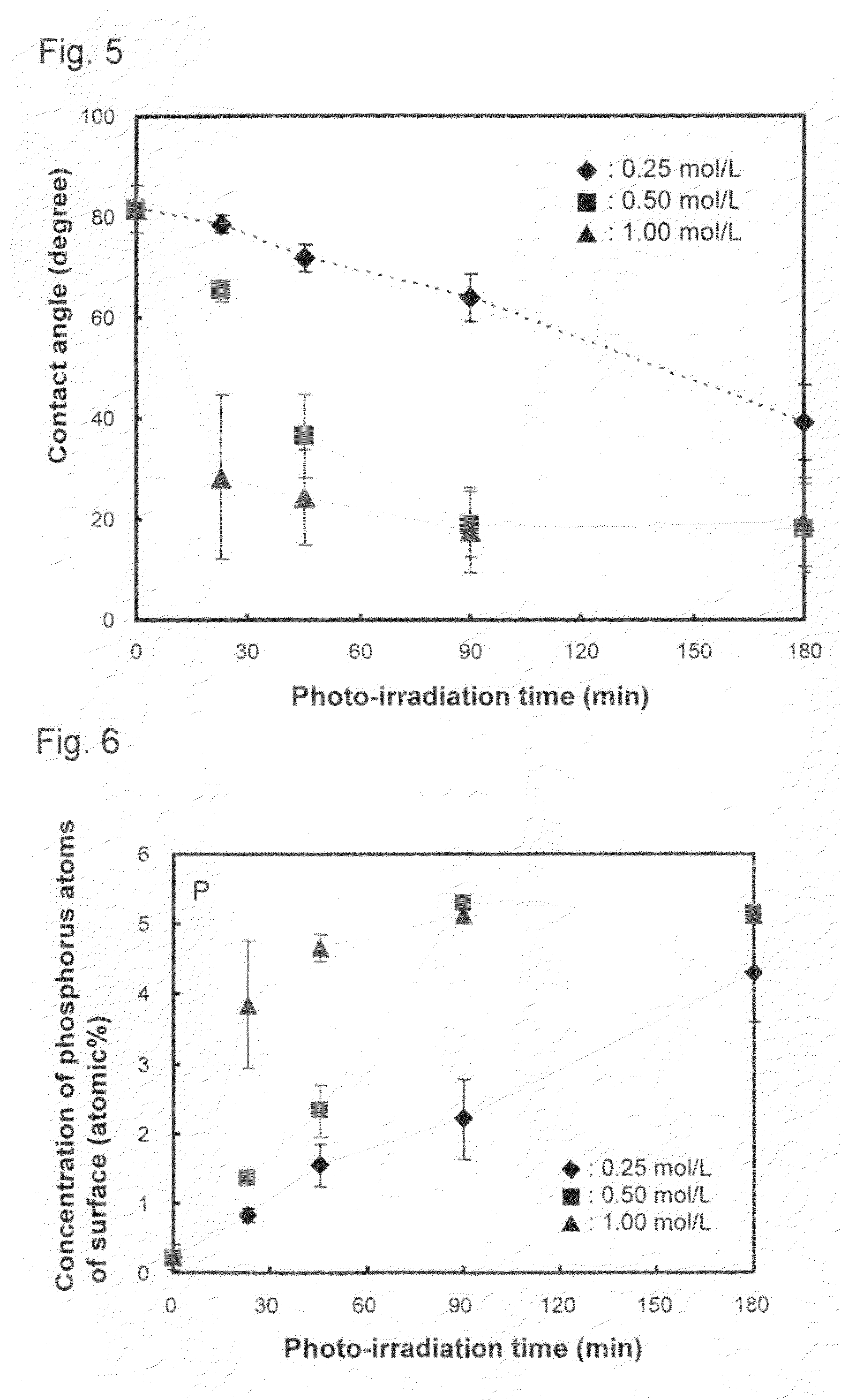Biocompatible and low-abrasion member, and artificial joint using the same and method of producing the same
a low-abrasion, biocompatible technology, applied in the field of sliding members, can solve the problems of poor binding of isocyanate groups to random copolymers comprising allylamine and phosphorylcholine analogue groups, and insufficient bonding between random copolymers and the surface of medical devices, etc., to suppress the production of abrasive wear debris, suppress the production of abrasive wear
- Summary
- Abstract
- Description
- Claims
- Application Information
AI Technical Summary
Benefits of technology
Problems solved by technology
Method used
Image
Examples
embodiment 1
[0054]FIG. 1 is a schematic sectional view of a sliding member of Embodiment 1 according to the present invention. As shown in FIG. 1, the sliding member according to present Embodiment 1 includes a substrate 1 on which a surface treated layer 2 is formed by treating at least a section of the surface is treated, a binder layer 3 formed from silica laminated on the surface treated layer 2 of the substrate 1, and a biocompatible material layer 4 laminated on the binder layer 3.
[0055]The surface treated layer 2 is formed by treating the surface of the substrate 1 with an acid such as nitric acid. By treating the surface of the substrate 1 as described above, hydroxyl groups are formed and the hydroxyl groups serves as starting points of the dehydrating condensation reaction of a silane coupling agent.
[0056]First, the silane coupling agent is hydrolyzed to form silanol groups and the silanol groups are bonded with hydroxyl groups contained in the surface treated layer 2 through the dehy...
embodiment 2
[0083]FIG. 2 is a cross-sectional view of a joint prosthesis manufactured by the production method of the present invention. As shown in FIG. 2, the joint prosthesis according to the second embodiment of the present invention comprises a femoral head 10 made of metal, alloy or ceramic and an acetabular cup 20 made of organic material. The femoral head 10 has a surface processed layer 11 on at least one section of the femoral head 10. The surface processed layer 11 is formed by processing at least one section of the surface of the femoral head 10. The femoral head 10 has a binder layer 12 laminated on the surface processed layer 11 and a biocompatible material layer 13 laminated on the binder layer 12. The femoral head 10 made of metal, alloy or ceramic in a joint prosthesis according to the second embodiment of the present invention is coated with a biocompatible material layer 13 via the binder layer 12 and the surface processed layer 11 and therefore does not produce wear debris o...
embodiment 3
[0084]As shown in FIG. 3, a joint prosthesis according to the third embodiment of the present invention comprises a femoral head 10 made of metal, alloy or ceramic and an acetabular cup 20 made of organic material. The femoral head 10 and the acetabular cup 20 have a surface-treated layer 11, 21 on at least one section thereof respectively. The surface-treated layer 11 is formed by treatment at least one section of the surface of the femoral head 10 or the acetabular cup 20. The femoral head 10 has a binder layer 12 laminated on the surface-treated layer 11 and a biocompatible material layer 13 laminated on the binder layer 12. These biocompatible material layers 13 are placed in contact.
[0085]The acetabular cup 20 is prepared by known methods (disclosed in, for example, Japanese Unexamined Patent Publication (Kokai) No. 2003-310649) in which the acetabular cup 20 is immersed in an acetone solution containing benzophenone, and then is immersed in an aqueous solution containing a bio...
PUM
| Property | Measurement | Unit |
|---|---|---|
| Percent by atom | aaaaa | aaaaa |
| Nanoscale particle size | aaaaa | aaaaa |
| Nanoscale particle size | aaaaa | aaaaa |
Abstract
Description
Claims
Application Information
 Login to View More
Login to View More - R&D
- Intellectual Property
- Life Sciences
- Materials
- Tech Scout
- Unparalleled Data Quality
- Higher Quality Content
- 60% Fewer Hallucinations
Browse by: Latest US Patents, China's latest patents, Technical Efficacy Thesaurus, Application Domain, Technology Topic, Popular Technical Reports.
© 2025 PatSnap. All rights reserved.Legal|Privacy policy|Modern Slavery Act Transparency Statement|Sitemap|About US| Contact US: help@patsnap.com



